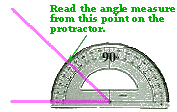|

Dictionary
A
B
C
D
E
F
G
H
I
J
K
L
M
N
O
P
Q
R
S
T
U
V
W
X
Y
Z
- palindrome
- Words, numbers and phrases that can be read the same backwords as forwards. Some examples include: "mom", "racecar", "34543", or the phrase "never odd or even".
- paradox
- A statement that appears to contradict itself, for example, suggesting a solution which is actually impossible (cfTortoise and Hare Race).
- parallel
- Lines that are in the same
plane that do not intersect (cfRectangles Discussion).
- parallelogram
- A quadrilateral
that contains two pairs of parallel sides (cfParallelograms Discussion, Rectangle Discussion).
- pattern
- Characteristic(s) observed in one item that may be repeated in similar or identical manners in other items.
- percent
- A ratio that compares a
number to one hundred. The symbol for percent is % (cf
Percents Discussion).
- perimeter
- The sum of the lengths of
all the sides of a polygon. (cfLength, Area, and Perimeter Lesson).
- permutation
- A a particular ordering
of a set of objects. For example, given the set {1, 2, 3}, there are six
permutations: {1, 2, 3}, {1, 3, 2}, {2, 1, 3}, {2, 3, 1}, {3, 1, 2}, and
{3, 2, 1}.
- personal view
- An approach taken
by mathematicians and philosophers to calculate probability.
Using their knowledge and reasoning skills, they think through the problem.
See theories of probability (cf
Probability vs. Statistics Discussion).
- Pi
- The designated name for the ratio of the circumference of a circle to its diameter.
- pie graph
- A diagram showing a system of connections or interrelations between two or more things
by using a circle divided into segments that look like pieces of pie.
- polygon
- A closed plane figure formed
by three or more line segments that do not cross over each other. (cf
What Are Tessellations
Discussion).
- polyhedra
- Any solid figure with an outer surface composed
of polygon faces (cf Polyhedra Discussion).
- prime number
- A number that has exactly
two factors, 1 and the number itself (cf
Venn Diagrams Discussion).
- prisoners
- values for c in the Julia Set or Mandelbrot set where at each iteration
the resulting value becomes smaller and smaller, approaching zero (cf Prisoners and Escapees -- Julia Sets Discussion).
- probability
- The measure of how likely it is for an event to occur. The probability of an event is
always a number between zero and 100%. The meaning
(interpretation) of probability is the subject of theories of probability. However,
any rule for assigning probabilities to events has to satisfy the axioms of probability.
- proportion
- A relationship between two ratios in which the first ratio is always equal to the second.
- protractor

An instrument for laying down and measuring angles on paper, used in drawing and
plotting (cf From Geometry to Probability Discussion).
- Pythagorean Theorem
- Used to find side lengths of right triangles, the Pythagorean Theorem states that the square of the hypotenuse is equal to the squares of the two sides, or A2 + B2 = C2, where C is the hypotenuse.
A
B
C
D
E
F
G
H
I
J
K
L
M
N
O
P
Q
R
S
T
U
V
W
X
Y
Z
|